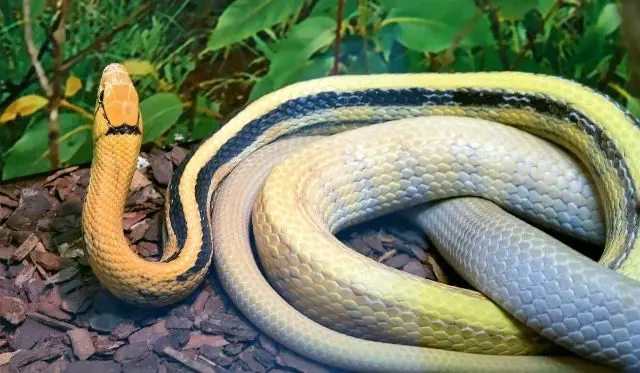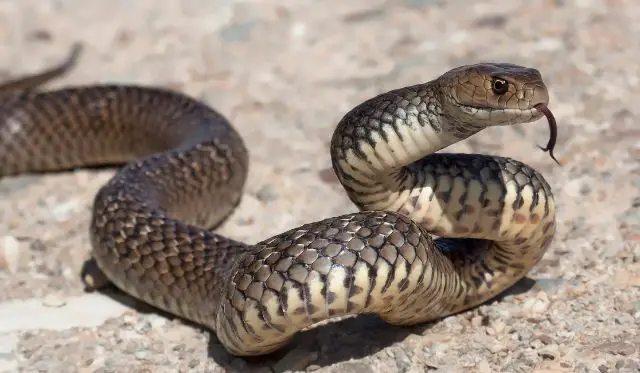Snakes are probably one of the most feared animals on the planet. Even if you’re never seen one and don’t live near any, I’d bet the thought of snakes sends a shiver up your spine.
How much do you really know about these ancient creatures that slither around the earth?
Luckily for you, I’ve got 20 interesting facts about snakes. However, I can’t guarantee you’ll fear them any less, especially when you read fact 19.

1. There are about 3,900 species of snakes in the world
With 3,900 species of snake slithering around the planet, there are plenty of different kinds that can scare you in multiple different ways. Whether that’s the colossal anaconda or the deadly inland taipan, they’ve evolved in different ways and adapted to their environments.
2. Snakes need external sources to warm up, or they can’t survive
Snakes are cold-blooded reptiles, which means they need external warmth to survive, such as the sun. Without this external warmth, they wouldn’t have the ability to move or digest their food.
Any source of warmth is acceptable, so nocturnal snakes will find something other than the sun to keep them warm. This need for heat is why you might find snakes coming into homes during winter because they are looking for warmth; they’re not specifically looking for you.
3. Snakes are carnivores
Snakes only eat meat, and depending on the snake species, this could be warm-blooded animals such as rodents or birds. In contrast, others prefer insects, others reptiles, and some even eat other snakes.
While snakes do have teeth, they do not chew their food and simply swallow it whole. Instead, their digestive system will take care of the rest.
4. Snakes are fast, at 12.5 mph!
Because there are so many different species of snakes, they all have varying speeds. But they’re all relatively fast, with an average speed of 12.5 mph.
An anaconda for example, can swim at 10 mph and on land can slither at 5 mph. A sidewinder, which people consider the fastest, can slither at 18 mph.
How fast can you run? The average adult human can run between 5-6 mph.
5. Over one million people own pet snakes in the US
There are about 329 million people in the US, 1 million of which own at least one pet snake. While there are about six fatalities a year from snake bites, these aren’t specifically from the pet snakes, as the US is home to many different species of wild snakes.
6. Snakes don’t hibernate, they brumate
Because snakes rely on warmth (often the sun) to keep functioning, during cold winter months when the sun is not available they will brumate, which is similar to hibernation.
They will sleep for most of the time. However, snakes will get up for a bit of food or water when required. They’ll also wake up if there is a sudden temperature change and the sun comes out, so they can recharge their batteries.
7. Snakes don’t need to eat every day
Unlike most humans that eat every day, snakes don’t need to. Depending on the snake, they could eat once or twice a week, once every one to two weeks, or if food is not available even longer.
It’s been observed that some snakes can go without food for up to two years, though it’s unknown what kind of effects this has on them and how well they recover once they start eating again.
8. The biggest snakes can be 33 feet long
Snakes come in mostly one shape but different sizes. The longest snake recorded was 33 feet long, which was an anaconda found in Brazil.
Anacondas are generally considered the largest, with records showing them reaching the 19-29 foot range.
9. Snakes aren’t poisonous
You might think snakes are poisonous, but they’re actually venomous. The difference is that if something is poisonous, it’s harmful when you eat it. However, many cultures eat snakes as a delicacy or even a cure for ailments. It’s when snakes bite you that there is a problem.
You will find snakes used in Cantonese and Vietnamese dishes, as well as many others.
10. Snakes don’t have eyelids
Would it unnerve you to know that snakes don’t blink? Because they don’t have eyelids so can’t blink.
They have a transparent protective layer over their eyes so they don’t dry out; this is called a brille. But that doesn’t change the fact that snakes are always watching.
11. Snakes evolved 142 million years ago
Snakes are thought to have evolved about 142 – 167 million years ago. The wide diversity of snakes we see today started around 56 – 66 million years ago.
If you look at modern humans, we’ve only been around for about 200,000 years.
12. Snakes are almost everywhere on the planet
Snakes are in almost every part of the planet. The few exceptions are Antarctica, Iceland, Ireland, Greenland, and New Zealand.
Most of the exceptions are due to climate. The last ice age covered these areas, making them uninhabitable to cold-blooded snakes. They’re also islands that make it hard for snakes to reach.
13. Not all snakes lay eggs
You may or may not know that reptiles lay eggs; however, not all snakes lay eggs, and some have live births.
The main reason for this is that the climate is too harsh for an egg to survive, whether that’s because it’s too cold or even too hot. So the egg stays inside the mother to hatch, and the live baby is released, ready for the world.
14. Snakes smell with their tongues
Smelling is generally done with your nose. However, snakes have a special organ on the roof of their mouth called the Jacobson’s organ. They use their tongues to grab chemicals in the air, then touch their tongue to the Jacobson’s organ, and this allows their brain to understand the smell.
15. Snakes don’t chew their food
Snakes are carnivores, so they only eat meat. However, they don’t chew the meat, they eat it whole and let their digestive system break down the food. Because the digestive enzymes can only work from the outside in, it can take some time to digest. The process is sped up the warmer the snake is.
Snakes do have teeth, but those teeth are not designed for chewing, only holding food.
16. Snakes shed their skin 4-12 times a year
I bet you’ve heard that snakes shed their skin, but did you know they do it 4-12 times a year?
Shedding their entire skin at once is a good way to grow and shed any parasites attached to them.

17. Snakes deliver less venom when you’re wearing denim
Something really interesting is that if you’re wearing denim and a snake bites you, it will inject less venom!
It isn’t so much that snakes don’t want to inject more; it’s that denim is a good defense mechanism to snake bikes.
18. The Green Anaconda snake can weigh up to 550 lbs
We know snakes can grow long, but they can also get extremely heavy. Weighing up to 550 lbs. The weight of an average American adult is 197 lbs.
However, the average American male has a 40-inch waist, while the circumference of one of these 550 lb Anacondas is only 30 inches, so we’ve got them beat there.
19. Some snakes can fly
If you thought walking through tall grass or digging around in your shed was a concern, now you need to look up in the sky as well to make sure a snake doesn’t get you.
Some snakes can fly or glide using aerial undulation. They will climb something tall such as a tree or pole, jump and then glide through the air. Spreading their ribs to give them better wind resistance, they also slither through the air, which allows them to travel further in the air.
20. Snakes never stop growing
Most humans will stop growing, except for some parts of their bodies. On the other hand, Snakes never stop growing, which is another reason they shed so often. Their bodies continue to grow, but their skin does not, so some of their shedding is due to the skin becoming too tight.
Final Thoughts
Snakes aren’t a major fear of mine because they’re generally big enough or loud enough to avoid. They’re not really looking to hurt you or interact with you at all.
However, reading all of the information required to make this article gave me a new appreciation for how amazing snakes are and an understanding of how long they’ve been around.
I hope you found these 20 facts interesting, learned a lot of new things about snakes, and might even go discover some more information that I didn’t include.
